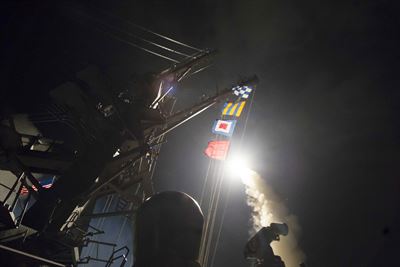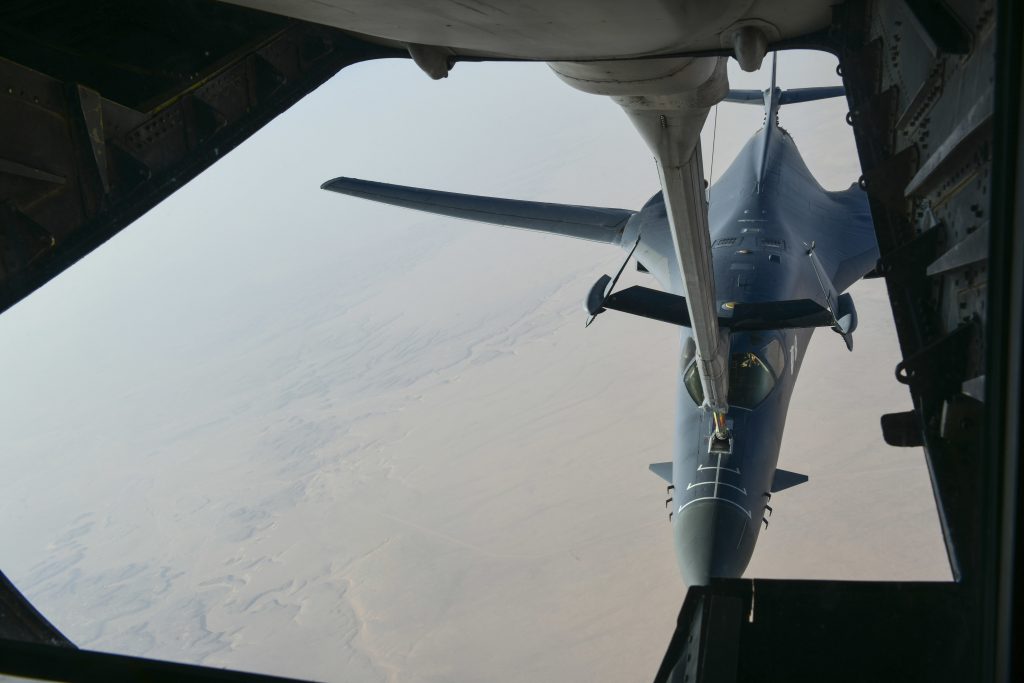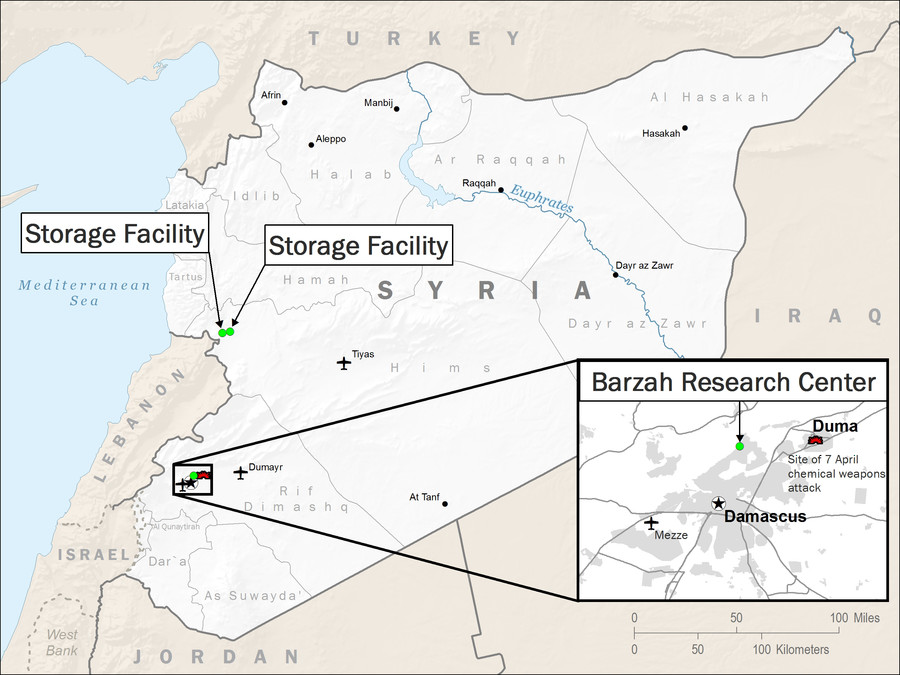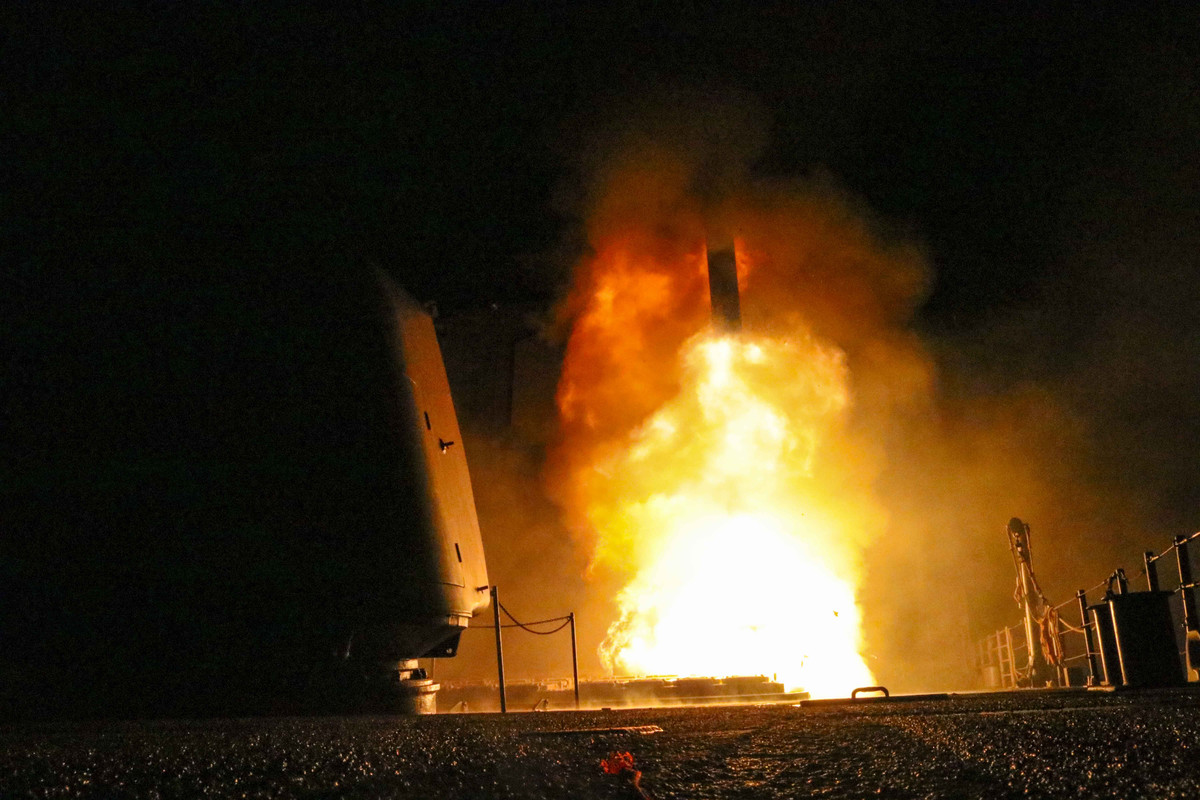
Update IV
Excerpts from a briefing by Chief Pentagon spokesperson Dana W. White and Marine Corps Lt. Gen. Kenneth F. McKenzie, the Joint Staff director, on the Syrian operation:
“It was successful…there were no allied casualties.”
The operation was carefully orchestrated and methodically planned to lessen chances of civilian casualties…The missiles hit targets during the Syrian pre-dawn hours, and planners, weaponeers and aircrew were careful to ensure little collateral damage. “We successfully hit every target…”
Missiles hit three distinct military chemical weapons targets…the fundamental components of the regime’s chemical weapons warfare infrastructure.
One target, the Barzah center, housed the regime’s research, development and production center for chemical and biological weapons. Photos taken after the strike show that where once three buildings stood, there is now nothing but rubble.
Strikes also hit a chemical weapons storage facility and a chemical bunker facility. “We selected these targets carefully to minimize the risk to innocent civilians…”
“We are still conducting a more detailed damage assessment, but initial indications are that we accomplished our military objectives without material interference. I would use three words to describe the operation: Precise, overwhelming and effective…”
The allies fired 105 weapons at these targets. The missiles came from British, French and American platforms in the Red Sea, the Persian Gulf and the Eastern Mediterranean.
“All weapons hit their targets close to the designated time on target.” The American ships were: the USS Monterrey, the USS Laboon, the USS Higgins and the submarine USS John Warner. Two B-1 Lancer bombers launched joint air-to-surface stand-off missiles. Support aircraft – tankers, fighters, electronic warfare aircraft and more – also participated.

An Air Force B-1 Bomber separates from the boom pod after receiving fuel from a KC-135 Stratotanker while en route to strike chemical weapons targets in Syria, April 14, 2018. Air Force photo
“None of our aircraft or missiles involved in this operation were successfully engaged by Syrian air defenses…We have no indication that Russian air defenses were employed.”
Syrian response was ineffectual as the Syrians launched surface-to-air missiles on a ballistic trajectory. “Most of the launches occurred after our strike was over…When you shoot iron into the air without guidance, it has to come down somewhere.”
Since the strike, U.S. officials have not seen any military response from actors within Syria. “We remain postured to protect our forces and those of the coalition should anything occur.”
Update III:
The U.S. military, along with British and French forces struck at three targets in Syria last night, believed to be a chemical weapons research center and storage facilities. (See map below)


The guided missile cruiser USS Monterey fires a Tomahawk missile in the U.S. 5th Fleet area of operations, April 14, 2018. Navy photo by Lt. j.g. Matthew Daniels
According to the Washington Post:
The attack involved munitions fired from aircraft and naval vessels, including about 100 Tomahawk cruise missiles, according to a Defense Department official who spoke on the condition of anonymity to discuss operational details. The Pentagon also employed the B-1 strategic bomber.
There was, however, a wider sense of relief that the strikes on three targets — believed to be research and storage cogs in Syrian’s chemical weapons production — had not caused Russian casualties, which could have led to a direct confrontation between Washington and Moscow.
Update II: Video of Secretrary Mattis’ briefing below
====
Update I: Statement by Secretary James N. Mattis at bottom
====
Statement by the DoD News, Defense Media Activity
U.S., French and British forces have struck targets in Syria as punishment for Syrian leader Bashar Assad using chemical weapons against his own people.
President Donald J. Trump announced the combined force launched precision strikes against the chemical weapons capabilities.
The strike against the capabilities is designed to stop Assad from using the banned weapons.
This is the second time the United States struck Assad’s chemical network. In April 2017, Trump ordered an attack against the Shayrat air base after Syrian aircraft at the base dropped bombs containing the nerve agent sarin. Some 58 missiles hit the aircraft and chemical weapons facilities at the base.
But the Syrian dictator did not learn the lesson, and the regime again launched poison gas against its own people April 7.
‘Evil and Despicable Act’
“This massacre was a significant escalation in a pattern of chemical weapons use by that very terrible regime,” Trump said during an announcement from the White House tonight. “The evil and despicable attack left mothers and fathers, infants and children thrashing in pain and gasping for air. These are not actions of a man; they are crimes of a monster instead.”
Chemical weapons have been banned since their widespread use during World War I. “The purpose of our action tonight is to establish a strong deterrent against the production, spread and use of chemical weapons,” the president said. “Establishing this deterrent is a vital national security interest of the United States. The combined American, French and British response to these atrocities will integrate all instruments of our national power.”
The president said the United States is prepared to sustain the response “until the Syrian regime stops its use of prohibited chemical agents.”
The Syrian regime is propped up by Russia and Iran. “To Iran and Russia I ask: What kind of a nation wants to be associated with a mass murderer of innocent men, women and children?” the president said. “The nations of the world can be judged by the friends they keep. No nation can succeed in the long run, by supporting rogue states, brutal tyrants and murderous dictators.”
Defense Secretary James N. Mattis called the chemical attack “beyond the pale” when he testified before the House Armed Services Committee yesterday. The attack, he said, was in “the worst interest of civilization itself.”
Not a Widening of U.S. Involvement
The action does not indicate a widening of U.S. involvement in Syria, the president said. U.S. troops are in eastern Syria to advise Syrian Democratic Forces in actions to eliminate the Islamic State of Iraq and Syria.
Chemical attacks, however, are a different and horrendous exception. The use of such weapons on civilians is particularly heinous. “In 2013, President [Vladimir] Putin and his government promised the world they would guarantee the elimination of Syria’s chemical weapons,” Trump said. “Assad’s recent attack and today’s response are a direct result of Russia’s failure to keep that promise.”
The Russians are now complicit in Syrian use of such weapons, and the nation must decide if they will continue its partnership with Assad or “join civilized nations as a force for stability and peace,” the president said.
The United States remains committed to the Geneva process and the U.N.-orchestrated effort. Russia continues to block this.
Statement by Secretary James N. Mattis on Syria
Good evening. As the world knows, the Syrian people have suffered terribly under the prolonged brutality of the Assad regime.
On April 7th, the regime decided to again defy the norms of civilized people, showing callous disregard for international law by using chemical weapons to murder women, children and other innocents. We and our allies find these atrocities inexcusable.
As our commander in chief, the president has the authority under Article II of the Constitution to use military force overseas to defend important U.S. national interests. The United States has an important national interest in averting a worsening humanitarian catastrophe in Syria, and specifically deterring the use and proliferation of chemical weapons.
Last year, in response to a chemical weapons attack against civilians and to signal the regime to cease chemical weapons use, we targeted the military base from which the weapons were delivered.
Earlier today, President Trump directed the U.S. military to conduct operations, in consonance with our allies, to destroy the Syrian regime’s chemical weapons research, development and production capabilities.
Tonight, France, the United Kingdom and the United States took decisive action to strike the Syrian chemical weapons infrastructure.
Clearly, the Assad regime did not get the message last year. This time, our allies and we have struck harder. Together, we have sent a clear message to Assad, and his murderous lieutenants, that they should not perpetrate another chemical weapons attack for which they will be held accountable.
The 70 nations in the defeat ISIS coalition remain committed to defeating ISIS in Syria. The strike tonight separately demonstrates international resolve to prevent chemical weapons from being used on anyone, under any circumstance, in contravention of international law.
I want to emphasize that these strikes are directed at the Syrian regime. In conducting these strikes, we have gone to great lengths to avoid civilian and foreign casualties.
But it is time for all civilized nations to urgently unite in ending the Syrian civil war by supporting the United Nations backed Geneva peace process.
In accordance with the chemical weapons convention prohibiting the use of such weapons, we urge responsible nations to condemn the Assad regime and join us in our firm resolve to prevent chemical weapons from being used again.
General Dunford will provide a military update.
Based on recent experience, we fully expect a significant disinformation campaign over the coming days by those who have aligned themselves with the Assad regime. In an effort to maintain transparency and accuracy, my assistant for public affairs, Dana White, and Lt. Gen. McKenzie, director of the Joint Staff, will provide a brief of known details tomorrow at 9:00 a.m.
Lead image: DoD File photo of April 2017 Tomahawk cruise missile strike on Syria
















